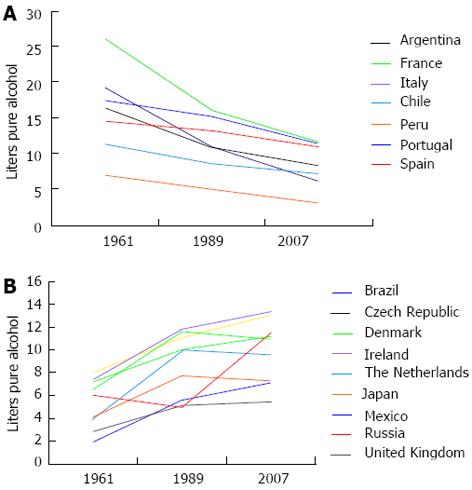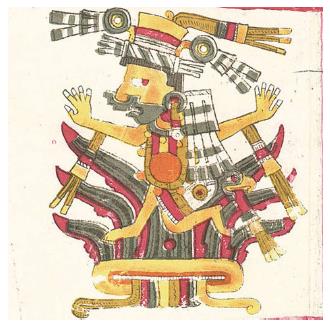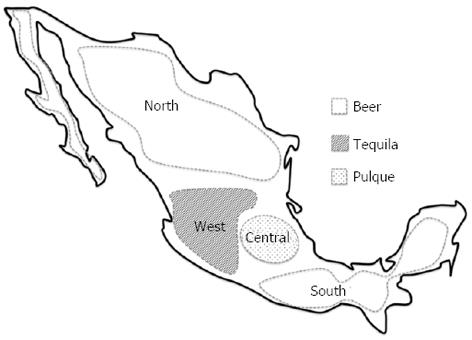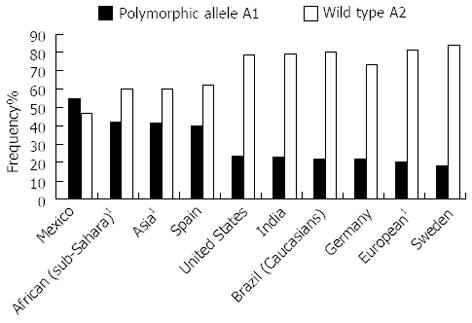Copyright
©2013 Baishideng Publishing Group Co.
World J Gastroenterol. Nov 28, 2013; 19(44): 7972-7982
Published online Nov 28, 2013. doi: 10.3748/wjg.v19.i44.7972
Published online Nov 28, 2013. doi: 10.3748/wjg.v19.i44.7972
Figure 1 Trends of per-capita alcohol consumption in different countries.
A: Countries that decreased consumption per capita since 1961 to 2007; B: Countries that increased consumption per capita since 1961 to 2007.
Figure 2 The tale of Mayahuel.
The ancient gods gathered in the heavens understood that their people got bored eating only maize and chili; thus, they sent Quetzalcóatl, the god of the winds, to bring the young and beautiful goddess Mayahuel, granddaughter of a “tzintzimitl, a star who attempted to prevent the sun from rising". Quetzalcóatl and Mayahuel fell in love and together promised that they would give their people a magic plant to recover their happiness. Meanwhile, the evil grandmother noticed that Mayahuel had disappeared; thus, she and other “tzintzimitl” went down to the earth to find her. Mayahuel and Quetzalcóatl were hidden in the form of a tree with two arms (branches); one arm was Mayahuel, and the other was Quetzalcóatl. When the grandmother found them, she cut Mayahuel´s arm into many small pieces, but not Quetzalcóatl’s, who was then transformed into a human again. Nothing could be done for Mayahuel, so Quetzalcóatl buried the leftover pieces in the ground and wept for his loss deeply. Finally, from these parts, the maguey was born. The mature maguey “cries” the honey-water, or “aguamiel”, that emerges from the center of the plant, representing the tears of Quetzalcóatl. “Octli poliuhqui” is the fermented nectar of the maguey that brings happiness. Thus, Mayahuel in the Nahuatl language stands for all that surrounds the maguey[16,17]. Mayahuel may be considered a dual deity. On the one hand, she represented a woman with many breasts who nourished many children, the 400 rabbits (“Centzon Totochtin”); thus, she was associated with the earth and fertility. On the other hand, she was associated with drunkenness and adultery. This mythological symbol had such great influence that one day of the month was devoted to the rabbit, and those born on that specific date were destined to either be a drunk or commit adultery[17,18].
Figure 3 Main types of alcoholic beverages consumed by geographical region in Mexico.
Figure 4 Frequency of Taq I A dopamine receptor D2 polymorphisms in different countries.
1HapMap.
Figure 5 Frequency of polymorphisms of enzymes that metabolize alcohol.
A: Alcohol dehydrogenase 2 (ADH2); B: Aldehyde dehydrogenase class 2 (ALDH2); C: Cytochrome P450 2E1 (CYP2E1) in different countries. A-B: Mexico 1: Western Mexico; Mexico 2: Native from Mexico “Otomi”; Mexico 3: Native from Mexico “Huicholes”; Japan 1: Rural country; Japan 2: Mestizos from Japan; C: Mexico 1: Western Mexico; Mexico 2: North an central Mexico; Mexico 3: Native from Mexico “Huicholes”; Chile 1: Mestizos; Chile 2: Native from Chile “Mapuches”.
- Citation: Roman S, Zepeda-Carrillo EA, Moreno-Luna LE, Panduro A. Alcoholism and liver disease in Mexico: Genetic and environmental factors. World J Gastroenterol 2013; 19(44): 7972-7982
- URL: https://www.wjgnet.com/1007-9327/full/v19/i44/7972.htm
- DOI: https://dx.doi.org/10.3748/wjg.v19.i44.7972

















